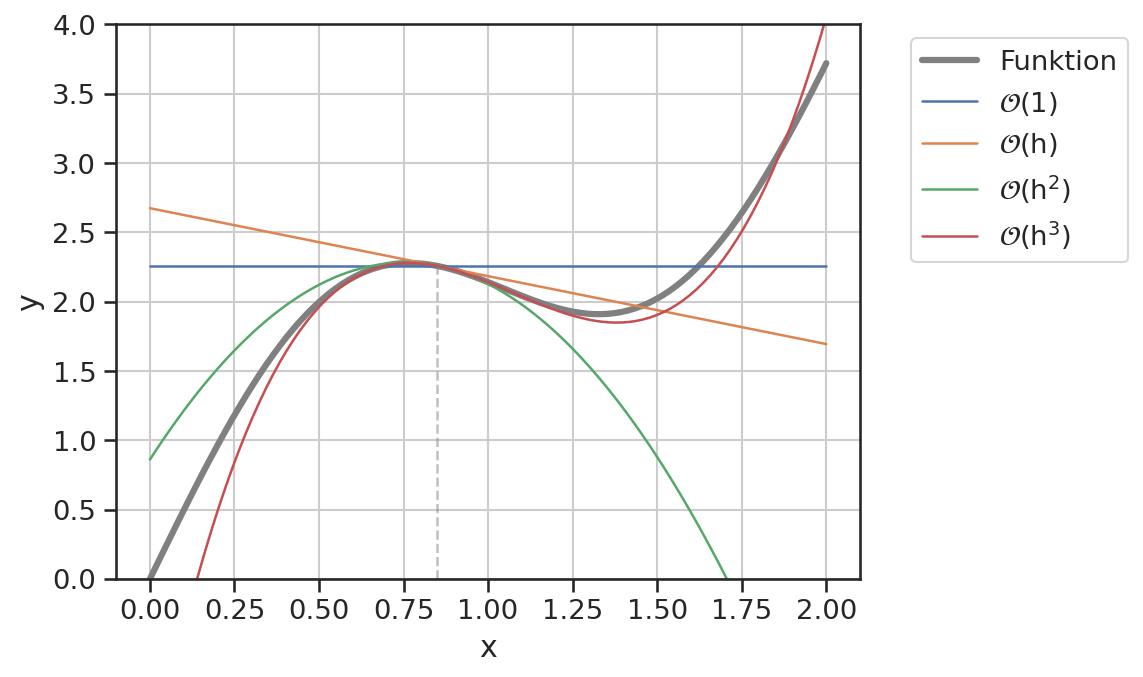4.2.1. Taylor-Entwicklung#
Show code cell source
import numpy as np
np.set_printoptions(precision=2, linewidth=65)
import matplotlib.pyplot as plt
plt.rc('figure', dpi=150)
import seaborn as sns
sns.set()
sns.set_style('ticks')
sns.set_context("notebook", font_scale=1.2, rc={"lines.linewidth": 1.2})
import scipy
Mittels der Taylor-Entwicklung kann jede beliebig oft stetig differenzierbare Funktion \(\sf f(x)\) um einem Entwicklungspunkt \(\sf x_0\) beliebig genau angenähert werden. Die funktionale Abhängigkeit bezieht sich nun auf die Variable \(\sf h\), welche nur in direkter Umgebung um \(\sf x_0\) betrachtet wird. Die Taylor-Entwicklung lautet:
Diese Entwicklung kann auch nur bis zu einer vorgegebenen Ordnung betrachtet werden. So nimmt die Entwicklung bis zur Ordnung \(\sf \mathcal{O}(h^3)\) folgende Form an:
Hierbei deutet das Landau-Symbol \(\sf \mathcal{O}\) die Ordnung an, welche die vernachlässigten Terme, hier ab \(\sf h^3\), als Approximationsfehler zusammenfasst. Die Ordnung gibt an wie schnell bzw. mit welchem funktionalem Zusammenhang der Approximationsfehler gegen Null läuft für \(\sf h \rightarrow 0\).
Eine graphische Darstellung der ersten Elemente der Reihe verdeutlichen nochmals die Grundidee. Das folgende Beispiel entwickelt die Funktion
am Punkt \(\sf x_0=0.85\).
def fkt(x, p=0):
if p==0:
return np.sin(3*x) + 2*x
if p==1:
return 3*np.cos(3*x) + 2
if p==2:
return -9*np.sin(3*x)
if p==3:
return -27*np.cos(3*x)
return None
# Daten für die Visualisierung
x = np.linspace(0, 2, 100)
y = fkt(x, p=0)
x0 = 0.85
# Taylor-Elemente
te = []
te.append(0*(x-x0) + fkt(x0, p=0))
te.append((x-x0) * fkt(x0, p=1))
te.append((x-x0)**2 * fkt(x0, p=2) * 1/2)
te.append((x-x0)**3 * fkt(x0, p=3) * 1/6)
plt.plot(x, y, color='Grey', lw=3, label="Funktion")
plt.plot(x, te[0], label="$\sf\mathcal{O}(1)$")
plt.plot(x, te[0] + te[1], label="$\sf\mathcal{O}(h)$")
plt.plot(x, te[0] + te[1] + te[2], label="$\sf\mathcal{O}(h^2)$")
plt.plot(x, te[0] + te[1] + te[2] + te[3], label="$\sf\mathcal{O}(h^3)$")
plt.vlines(x0, ymin=0, ymax=fkt(x0), color='Grey', ls='--', alpha=0.5)
plt.ylim([0,4])
plt.legend(bbox_to_anchor=(1.05, 1.0), loc='upper left')
plt.grid()
plt.xlabel('x')
plt.ylabel('y');

